|
|
|
| |
Movimiento orbital de Venus vista desde la tierra y sus puntos sagrados de las tradiciones indígenas. Se usan para relacionarlos con la Rueda Sagrada y realizar un calendario.
|
|
|
|
Venus, el Lucero del Alba
Publicado el 29 noviembre, 2010 por bitacoradegalileo

Sólo superado en brillo por el Sol y la Luna, Venus es conocido desde siempre, si bien con ciertas confusiones, pues los antiguos creyeron que se trataba de dos astros distintos, al amanecer (Phosphorus) y al atardecer (Hesperus),  hasta el punto de hacerse visible incluso de día, en frecuentes ocasiones, siendo el primer astro en aparecer en muchos atardeceres, y el último en desaparecer en el amanecer. En la fotografía, tomada a las 7 de la tarde en Budapest (Hungría), aparece a punto de ser ocultado por la Luna. El planeta volvería a aparecer una hora después.Estrella de la mañana (Morning Star para los angloparlantes, o Morgensternpara los alemanes), Lucero de la tarde e incluso La Joya del Cielo son denominaciones frecuentes para el planeta Venus. Llega a alcanzar una magnitud visual de -4.40. hasta el punto de hacerse visible incluso de día, en frecuentes ocasiones, siendo el primer astro en aparecer en muchos atardeceres, y el último en desaparecer en el amanecer. En la fotografía, tomada a las 7 de la tarde en Budapest (Hungría), aparece a punto de ser ocultado por la Luna. El planeta volvería a aparecer una hora después.Estrella de la mañana (Morning Star para los angloparlantes, o Morgensternpara los alemanes), Lucero de la tarde e incluso La Joya del Cielo son denominaciones frecuentes para el planeta Venus. Llega a alcanzar una magnitud visual de -4.40.

Tras Mercurio, Venus es el segundo planeta más cercano al Sol, y ambos se constituyen como los únicos interiores a la órbita de la Tierra, por lo que nunca podrán encontrarse en oposición. Su tamaño es mayor que el del propioMercurio, y también que el de Marte, y sólo es superado por el de la Tierraentre los llamados planetas rocosos o terrestres. Venus (como Mercurio) no tiene ningún satélite natural.
 Como se encuentra más cerca del Sol que nosotros, muchas veces se sitúa demasiado cerca de éste, y esto impide su visión, así es que es necesario, para observarlo, esperar a que obtenga una suficiente separación angular de la estrella. A esta separación es a lo que los astrónomos llaman elongación, que en el caso de Venus sólo obtendrá un valor máximo de 47.8º, lo que hace que en estos días se pueda ver con un margen de más de 3 horas antes de la salida del Sol, o después de su ocaso. Como se encuentra más cerca del Sol que nosotros, muchas veces se sitúa demasiado cerca de éste, y esto impide su visión, así es que es necesario, para observarlo, esperar a que obtenga una suficiente separación angular de la estrella. A esta separación es a lo que los astrónomos llaman elongación, que en el caso de Venus sólo obtendrá un valor máximo de 47.8º, lo que hace que en estos días se pueda ver con un margen de más de 3 horas antes de la salida del Sol, o después de su ocaso.
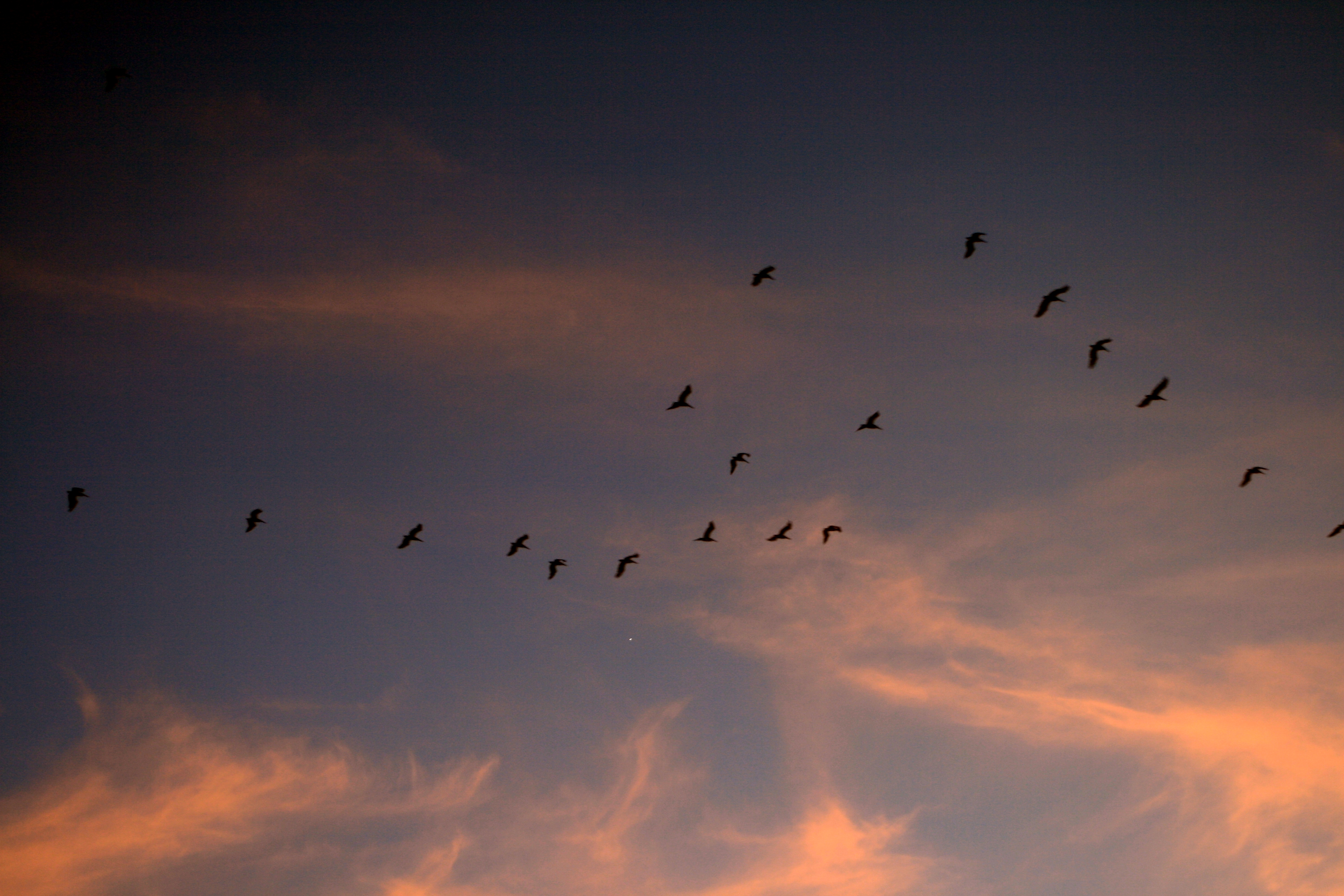
 A continuación he incluido un cuadro donde figuran los horarios de orto por el este, tránsito en el sur (en el norte para el Hemisferio Austral), y ocaso por el oeste para el planeta Venus en los cuatro domingos de este mes de diciembre (escribo a finales del mes de noviembre de 2010). A continuación he incluido un cuadro donde figuran los horarios de orto por el este, tránsito en el sur (en el norte para el Hemisferio Austral), y ocaso por el oeste para el planeta Venus en los cuatro domingos de este mes de diciembre (escribo a finales del mes de noviembre de 2010).
| Día | Salida | Culminación | Ocaso | Magnitud |
| 05 |
5:02 |
10:32 |
16:02 |
-2.6 |
| 12 |
4:55 |
10:22 |
15:50 |
-2.9 |
| 19 |
4:52 |
10:16 |
15:40 |
-3.1 |
| 26 |
4:53 |
10:12 |
15:32 |
-3.3 |
Desde Cádiz (España), podrá observarse perfectamente antes del amanecer, porque el Sol no saldrá por el este hasta pasadas las 8 de la mañana. En ese momento, el planeta habrá alcanzado una altitud superior a los 33º sobre el horizonte del sureste.

Al igual que nuestro satélite, la Luna, Venus presenta fases. Sabemos esto desde que lo descubrió Galileo Galilei, cuando observó al 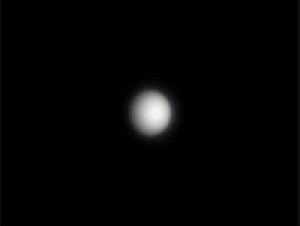 planeta en el mes de diciembre de 1.610, así es que en estas fechas se cumplen 400 años de tan importante descubrimiento, pues el genial astrónomo toscano también anotó el menor tamaño del astro cuando mostraba fase llena, que iba aumentando conforme disminuía la superficie iluminada (pulse sobre la imagen), y ese dato supuso un importante espaldarazo en favor del modelo heliocéntrico propuesto por Nicolás Copérnico. planeta en el mes de diciembre de 1.610, así es que en estas fechas se cumplen 400 años de tan importante descubrimiento, pues el genial astrónomo toscano también anotó el menor tamaño del astro cuando mostraba fase llena, que iba aumentando conforme disminuía la superficie iluminada (pulse sobre la imagen), y ese dato supuso un importante espaldarazo en favor del modelo heliocéntrico propuesto por Nicolás Copérnico.

Durante un tiempo, los astrónomos pensaron que la Tierra y Venus eran dos planetas gemelos. Esta creencia se sustentaba en que los dos astros tienen aproximadamente el mismo tamaño, y similar masa, densidad y volumen, como puede verse en el siguiente cuadro:
| Dato | Venus | Tierra | Venus/Tierra |
| Masa (x1024 kg) |
4.8685 |
5.9736 |
0.815 |
| Densidad (kg/m3) |
5243 |
5515 |
0.951 |
| Radio (km) |
6051.8 |
6378.1 |
0.949 |
| Gravedad (m/s2) |
8.87 |
9.78 |
0.905 |
|
|
|
|
|
Como se ve, las similitudes rondan el 90 %, y además se formaron casi al mismo tiempo, y de la misma nebulosa. Por todas esas razones, hace un siglo imaginábamos a Venus cubierto por océanos rodeados de hermosos jardines, y habitado por seres inteligentes (venusianos).

Sin embargo, la realidad es bien distinta, y esto lo supimos en la era espacial, cuando la sonda norteamericana Mariner 2 pudo llegar al planeta, tras el fracaso un año antes de la soviética Venera I,  mostrando la densa atmósfera que lo rodea, y que impide ver la superficie del planeta. En 1974, laVenera 4 envió datos de la composición de esta atmósfera, y supimos que estaba compuesta por un 95 % de dióxido de carbono. Distintas misiones midieron la presión atmosférica (entre 75 y 100 atmósferas) y la temperatura en la superficie (entre 457 y 474 ºC), entre otros valores, mostrando la densa atmósfera que lo rodea, y que impide ver la superficie del planeta. En 1974, laVenera 4 envió datos de la composición de esta atmósfera, y supimos que estaba compuesta por un 95 % de dióxido de carbono. Distintas misiones midieron la presión atmosférica (entre 75 y 100 atmósferas) y la temperatura en la superficie (entre 457 y 474 ºC), entre otros valores, radicalmente distintos a los de nuestro planeta. La densa atmósfera produce además un efecto invernadero, dejando pasar las radiaciones infrarrojas, que no podrán salir al exterior, y filtrando las ultravioletas radicalmente distintos a los de nuestro planeta. La densa atmósfera produce además un efecto invernadero, dejando pasar las radiaciones infrarrojas, que no podrán salir al exterior, y filtrando las ultravioletas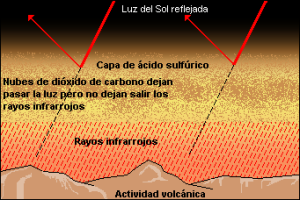 procedentes del Sol, originando las altas temperaturas que ya se han citado. Si a todo esto unimos la actividad volcánica que parecen confirmar los datos enviados por la sondaVenus Express, de laAgencia Espacial Europea, actualmente en órbita alrededor de Venus, estudiando su atmósfera y su superficie, podremos hacernos una idea de que se trata de un verdadero infierno. procedentes del Sol, originando las altas temperaturas que ya se han citado. Si a todo esto unimos la actividad volcánica que parecen confirmar los datos enviados por la sondaVenus Express, de laAgencia Espacial Europea, actualmente en órbita alrededor de Venus, estudiando su atmósfera y su superficie, podremos hacernos una idea de que se trata de un verdadero infierno.

La estructura interna del planeta parece ser semejante a la de la Tierra, aunque con algunas diferencias que resultarán decisivas en cuanto a la ausencia de un campo magnético significativo. Todo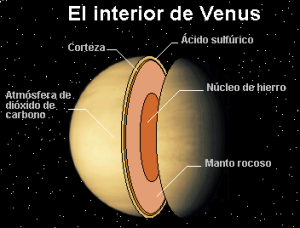 induce a pensar que en Venus hay un núcleo metálico, líquido al menos en parte, cubierto por un manto de silicatos, y una corteza carente de placas tectónicas, lo que unido a una lenta rotación deja en solitario al viento solar como único responsable de la débil actividad magnética en los polos. La lava presente en la superficie, relativamente reciente, ha de ser forzosamente procedente de la actividad volcánica, porque no se producen movimientos tectónicos como en la Tierra. induce a pensar que en Venus hay un núcleo metálico, líquido al menos en parte, cubierto por un manto de silicatos, y una corteza carente de placas tectónicas, lo que unido a una lenta rotación deja en solitario al viento solar como único responsable de la débil actividad magnética en los polos. La lava presente en la superficie, relativamente reciente, ha de ser forzosamente procedente de la actividad volcánica, porque no se producen movimientos tectónicos como en la Tierra.

La sonda Magallanes ha elaborado, con el auxilio de radares, un completo mapa de la superficie venusiana, en la que destacan dos mesetas, jalonadas por ríos de lava de formación reciente (a escala  geológica), pues no parecen tener más de 500 millones de años. La primera y más extensa de esas formaciones es la Tierra de Afrodita, que se extiende a lo largo de toda la zona ecuatorial. El brillo de la región, que se manifiesta en las fotografías de la sonda, sugiere la presencia de materiales metálicos (¿pirita de hierro?), pues hay que descartar la presencia de humedad geológica), pues no parecen tener más de 500 millones de años. La primera y más extensa de esas formaciones es la Tierra de Afrodita, que se extiende a lo largo de toda la zona ecuatorial. El brillo de la región, que se manifiesta en las fotografías de la sonda, sugiere la presencia de materiales metálicos (¿pirita de hierro?), pues hay que descartar la presencia de humedad  procedente de agua líquida.. Otra meseta, la Tierra de Ishtar, se sitúa en los alrededores del Polo Norte, y en ella encontramos el Monte Maxwell, que con casi 11.000 metros (2 km más alto que el Everest) es la mayor altitud del planeta. En la ilustración de arriba a la derecha, el Everest está en primer término, después el Monte Maxwell, y por fin al fondo, el imponente Monte Olimpo, en procedente de agua líquida.. Otra meseta, la Tierra de Ishtar, se sitúa en los alrededores del Polo Norte, y en ella encontramos el Monte Maxwell, que con casi 11.000 metros (2 km más alto que el Everest) es la mayor altitud del planeta. En la ilustración de arriba a la derecha, el Everest está en primer término, después el Monte Maxwell, y por fin al fondo, el imponente Monte Olimpo, en  Marte, que con sus 27 km de altura es el mayor volcán del Sistema Solar. Junto a estas líneas, a la izquierda, fotografía por radar deMaat Mons (8 km), que es el volcán más alto deVenus, tomada por la sonda Magallanes. En primer término se evidencian ríos de lava de reciente formación, y también se han podido detectar en la zona altas concentraciones de Dióxido de Azufre (SO2) y Metano(CH4), consecuencia de las recientes emisiones del volcán. Marte, que con sus 27 km de altura es el mayor volcán del Sistema Solar. Junto a estas líneas, a la izquierda, fotografía por radar deMaat Mons (8 km), que es el volcán más alto deVenus, tomada por la sonda Magallanes. En primer término se evidencian ríos de lava de reciente formación, y también se han podido detectar en la zona altas concentraciones de Dióxido de Azufre (SO2) y Metano(CH4), consecuencia de las recientes emisiones del volcán.

El planeta Venus en color verdadero, donde sólo se aprecia la densa atmósfera, sin detalle alguno de su superficie
En cuanto a sus aspectos orbitales, las diferencias con la Tierra se agudizan.Venus rota lentamente, siendo su período de rotación de 243 días terrestres (un día venusiano). Sin embargo, su año es de sólo 225 días, resultando más corto que el día, referido éste a su posición con respecto al fondo estelar.
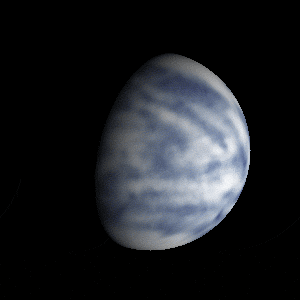
Pero lo más sorprendente es que si pudiéramos observar al Sol desde la superficie del planeta, nuestra estrella saldría por el oeste, poniéndose por el este, al contrario de lo que ocurre en la Tierra, pues su rotación es retrógrada. Naturalmente, el fenómeno también afecta al resto de las estrellas y a los planetas. Desde Venus, la Tierra aparece con magnitud -2.6 y la Luna con +1.39. Júpiter, con -1.6.

Por último, hemos de resaltar los interesantes tránsitos del planeta a través del disco solar. Consisten éstos en que, a pesar de que las  órbitas de la Tierra y deVenus difieren en su inclinación, a veces coincide nuestra posición en línea recta con las deVenus y el Sol, y entonces el planeta aparece como un lunar negro sobre el fondo luminoso de la estrella.Kepler había predicho el tránsito de Venus (y el deMercurio) en 1631, pero murió un año antes, así es que hasta 1639 no se observó el primero (Jeremiah Horrocks). El último ocurrió en el año 2004. El próximo, el 6 de junio de 2012. órbitas de la Tierra y deVenus difieren en su inclinación, a veces coincide nuestra posición en línea recta con las deVenus y el Sol, y entonces el planeta aparece como un lunar negro sobre el fondo luminoso de la estrella.Kepler había predicho el tránsito de Venus (y el deMercurio) en 1631, pero murió un año antes, así es que hasta 1639 no se observó el primero (Jeremiah Horrocks). El último ocurrió en el año 2004. El próximo, el 6 de junio de 2012.
Mitología
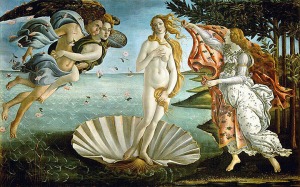 Ya citamos al principio del artículo que los antiguos griegos creyeron, durante un tiempo, que el astro que veían brillar por la mañana era otro distinto al de la tarde. Al primero lo llamaron Phosphorus oLucifer, que no significa otra cosa que el que trae la luz, en referencia a que aparecía inmediatamente antes que el Sol; el segundo fue llamado Hesperus. Pero cuando se dieron cuenta de que se trataba de un mismo astro, brindaron el planeta a Afrodita, imponiéndole su nombre. Los romanos continuaron la tradición helenística, y lo llamaron Ya citamos al principio del artículo que los antiguos griegos creyeron, durante un tiempo, que el astro que veían brillar por la mañana era otro distinto al de la tarde. Al primero lo llamaron Phosphorus oLucifer, que no significa otra cosa que el que trae la luz, en referencia a que aparecía inmediatamente antes que el Sol; el segundo fue llamado Hesperus. Pero cuando se dieron cuenta de que se trataba de un mismo astro, brindaron el planeta a Afrodita, imponiéndole su nombre. Los romanos continuaron la tradición helenística, y lo llamaron  Venus (heredera latina de Afrodita), la Diosa del Amor, que también representaba a la belleza y la fertilidad. Venus (heredera latina de Afrodita), la Diosa del Amor, que también representaba a la belleza y la fertilidad.
El símbolo del planeta, que también sirve para identificar al sexo femenino, representa al espejo en el que Venus se mira, en oposición a la lanza de Marte, que simboliza el sexo masculino.
Volver al principio del artículo.
Volver al principio de la bitácora.
Ir al Índice Temático.
|
|
|
|
|
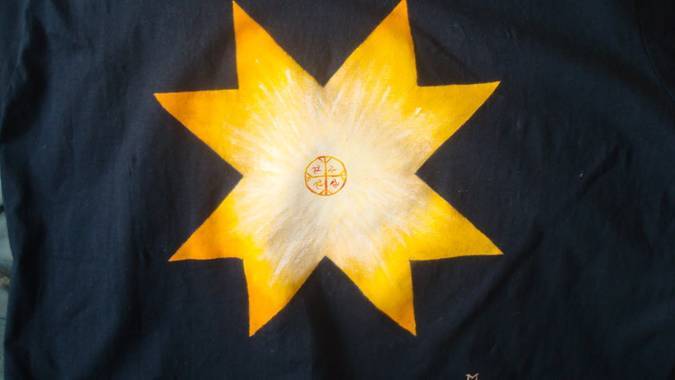
Para los mapuches Venus era y es Guñelve, la blanca estrella solitaria de ocho puntas, y en el kultrún aparece dibujada en lados opuestos, para explicar su presencia tanto como “estrella de la mañana” y como “estrella de la tarde”. Al igual que los mayas, los mapuches conocían tan bien el desplazamiento de Venus en el firmamento, hasta el punto de calcular con bastante exactitud su “período sinódico” el cual se completa en cerca de 583 días. Solían dibujarlo como una estrella de ocho puntas y su símil terrestre era y es la blanca flor del foye (canelo).Para los mapuches Venus era y es Guñelve, la blanca estrella solitaria de ocho puntas, y en el kultrún aparece dibujada en lados opuestos, para explicar su presencia tanto como “estrella de la mañana” y como “estrella de la tarde”. Al igual que los mayas, los mapuches conocían tan bien el desplazamiento de Venus en el firmamento, hasta el punto de calcular con bastante exactitud su “período sinódico” el cual se completa en cerca de 583 días. Solían dibujarlo como una estrella de ocho puntas y su símil terrestre era y es la blanca flor del foye (canelo).
http://sabijabi-blog.tumblr.com/ |
|
|
|
|

Para los mapuches Venus era y es Guñelve, la blanca estrella solitaria de ocho puntas, y en el kultrún aparece dibujada en lados opuestos, para explicar su presencia tanto como “estrella de la mañana” y como “estrella de la tarde”. Al igual que los mayas, los mapuches conocían tan bien el desplazamiento de Venus en el firmamento, hasta el punto de calcular con bastante exactitud su “período sinódico” el cual se completa en cerca de 583 días. Solían dibujarlo como una estrella de ocho puntas y su símil terrestre era y es la blanca flor del foye (canelo).Para los mapuches Venus era y es Guñelve, la blanca estrella solitaria de ocho puntas, y en el kultrún aparece dibujada en lados opuestos, para explicar su presencia tanto como “estrella de la mañana” y como “estrella de la tarde”. Al igual que los mayas, los mapuches conocían tan bien el desplazamiento de Venus en el firmamento, hasta el punto de calcular con bastante exactitud su “período sinódico” el cual se completa en cerca de 583 días. Solían dibujarlo como una estrella de ocho puntas y su símil terrestre era y es la blanca flor del foye (canelo).
http://sabijabi-blog.tumblr.com/
|
|
|
|
|
Marco Vitruvio
Marco Vitruvio Polión (en latín Marcus Vitruvius Pollio; c. 80-70 a. C.-15 a. C.) fue unarquitecto, escritor, ingeniero y tratadista romano del siglo I a. C.
Biografía y obra[editar]
Fue arquitecto de Julio César durante su juventud, y al retirarse del servicio entró en la arquitectura civil, siendo de este periodo su única obra conocida, la basílica de Fanum (en Italia). Es el autor del tratado sobre arquitectura más antiguo que se conserva y el único de la Antigüedad clásica, De Architectura, en 10 libros (probablemente escrito entre los años 27 a. C. y 23 a. C.). Inspirada en teóricos helenísticos –se refiere expresamente a inventos del gran Ctesibio–, la obra trata sobre órdenes, materiales, técnicas decorativas, construcción, tipos de edificios,hidráulica, colores, mecánica y gnomónica (Libro IX).
El último libro está dedicado a las máquinas: de tracción, elevadoras de agua y todo tipo de artefactos bélicos (catapultas, ballestas, tortugas, etc.). Vitruvio describió muy bien la rueda hidráulica en el cap. X.5. La rueda de Vitruvio era vertical y el agua la empujaba por abajo; unosengranajes tenían la finalidad de cambiar la dirección del giro y aumentar la velocidad de las muelas; se calcula que con la energía producida por una de estas ruedas se podían moler 150 kg de trigo por hora, mientras que dos esclavos solo molían 7 kg.1
De Architectura, conocido y empleado en la Edad Media, se imprimió por primera vez en Roma en1486, edición del humanista y gramático Fray Giovanni Sulpicio de Veroli, ofreciendo al artista delRenacimiento, imbuido de la admiración por las virtudes de la cultura clásica tan propio de la época, un canal privilegiado mediante el que reproducir las formas arquitectónicas de la antigüedad greco-latina. Posteriormente, se publicó en la mayor parte de los países y todavía hoy constituye una fuente documental insustituible, también por las informaciones que aporta sobre la pintura y la esculturagriegas y romanas.2 El famoso dibujo de Leonardo da Vinci, el Hombre de Vitruvio, sobre las proporciones del hombre está basado en las indicaciones dadas en esta obra. El dibujo se conserva ahora en la Galleria dell'Accademia, en Venecia. El gran redescubridor de Vitruvio fue Petrarca, y tras la difusión por el florentino de la obra de este autor clásico, se puede afirmar que Vitruvio sentó las bases de la arquitectura Renacentista.3
Las imágenes que ilustran la obra de Vitruvio, en sus ediciones hasta el siglo XVIII, no solo aclaran y embellecen el tratado grecorromano, sino que son expresión de distintas intenciones y usos que ese libro ha tenido en la modernidad europea.
De Architectura libri decem (De architectura) de Vitruvio[editar]

Plano de una casa griega según Vitruvio
Vitruvio es el autor de De architectura, conocido hoy como Los Diez Libros de Arquitectura,4 un tratado escrito en latín y griego antiguo acerca de arquitectura, dedicado al emperador Augusto. En el prefacio del libro I, Vitruvio dedica sus escritos para dar conocimiento personal de la calidad de los edificios al emperador. Probablemente Vitruvio se refiere a la campaña de reparaciones y mejoras públicas de Marco Agripa. Este trabajo es un gran libro y único superviviente de la arquitectura de la antigüedad clásica. Según Petri Liukkonen, este texto "influyó profundamente a los artistas desde el primer Renacimiento en adelante, como a pensadores y arquitectos, entre ellos Leon Battista Alberti (1404-1472), Leonardo da Vinci (1452-1519) y Miguel Ángel (1475-1564)."5 El siguiente libro importante en la arquitectura fue la reformulación de los diez libros de Alberti, que no fue escrito hasta 1452.
Vitruvio es famoso por afirmar en su libro De Architectura que ciertos edificios públicos deben exhibir las tres cualidades de firmitas, utilitas, venustas –es decir, deben ser sólidos, útiles, hermosos–. Estas cualidades a veces se llaman las virtudes de Vitruvio o la Tríada de Vitruvio. Desde el siglo XVII, esta Tríada se usa para describir la arquitectura en general, aunque la descripción vitruviana de la disciplina es muy diferente.
Según Vitruvio, la arquitectura es una imitación de la naturaleza. Como las aves y las abejas construyen sus nidos, los seres humanos construyen vivienda a partir de materiales naturales, que les da refugio contra los elementos. Para el perfeccionamiento de este arte de la construcción, los griegos inventaron los órdenes arquitectónicos: dórico, jónico y corintio. Se les dio un sentido de la proporción, que culminó en la comprensión de las proporciones de la mayor obra de arte: el cuerpo humano. Esto llevó Vitruvio a la definición de un canon del cuerpo humano, el Hombre de Vitruvio, adoptado más tarde por Leonardo da Vinci: el cuerpo humano inscrito en el círculo y el cuadrado (los patrones geométricos fundamentales del orden cósmico).
A Vitruvio se le considera a veces libremente como el primer arquitecto, pero es más exacto describirlo como el primer arquitecto romano que escribió registros de su campo que sobrevivieron. Él mismo cita a obras mayores, pero menos completas. Era al menos un pensador original o tenía el intelecto creativo de un codificador de la práctica arquitectónica existente. También hay que señalar que Vitruvio tenía un alcance mucho más amplio que los arquitectos modernos. Los arquitectos romanos practicaban una amplia variedad de disciplinas; en términos modernos, podrían describirse como la combinación de ingenieros, arquitectos, arquitectos paisajistas, artistas y artesanos. Etimológicamente la palabra arquitecto deriva de las palabras griegas que significan "maestro" y "constructor". El primero de los diez libros se ocupa de muchos temas que ahora entran en el ámbito de la arquitectura del paisaje.
Tecnología romana[editar]
Los Libros VIII, IX y X son la base de gran parte de lo que sabemos acerca de la tecnología romana, ahora aumentados por los estudios arqueológicos de los restos existentes, tales como los molinos de agua en Barbegal, Francia. La otra fuente importante de información es la Historia Naturalis compilada por Plinio el Viejo mucho más tarde en el año 75 de nuestra era.
El trabajo es importante por describir las diferentes máquinas utilizadas para estructuras de ingeniería, tales como montacargas, grúas y poleas, también máquinas de guerra, como catapultas, ballestas y máquinas de asedio. Como ingeniero practicante, Vitruvio debe estar hablando de la experiencia personal en lugar de la simple descripción de las obras de los demás. Asimismo se describe la construcción de relojes de sol y de agua, y el uso de un eolípila (la primera máquina de vapor ) como un experimento para demostrar la naturaleza de los movimientos de aire atmosféricas (viento).
Su descripción de la construcción de un acueducto incluye la forma en que se registran y la cuidadosa elección de los materiales necesarios, aunque Frontino (un general que fue nombrado a fines del Siglo Ipara administrar los numerosos acueductos de Roma) los describiría un siglo más tarde, con mucho más detalle acerca de los problemas prácticos involucrados en la construcción y el mantenimiento. Seguramente el libro de Vitruvio habría sido de gran ayuda en esto. Vitruvio escribió esto en el siglo I a. C., cuando muchos de los mejores acueductos romanos fueron construidos, y que sobreviven hasta nuestros días, como los de Segovia o Pont du Gard. El uso del sifón invertido se describe en detalle, junto con los problemas de altas presiones desarrolladas en la base del tubo del sifón, un problema práctico con el que parece estar familiarizado.
Vitruvio describe muchos diferentes materiales de construcción usados para una amplia variedad de diferentes estructuras, así como detalles tales como pintura estuco. El concreto y la cal reciben profundas descripciones, la longevidad de muchas estructuras romanas que son mudo testimonio de la habilidad de los romanos en los materiales de construcción y diseño.
Vitruvio es muy conocido y citado a menudo como una de las fuentes más antiguas que sobreviven por haber advertido que el plomo no se debe utilizar para conducir el agua potable, recomendando en cambio pipas de arcilla o canales de mampostería. Se llega a esta conclusión en el Libro VIII De Architectura después de la observación empírica de las aparentes enfermedades de los obreros en las fundiciones de plomo de su tiempo.6
Vitruvio fue el que nos relató la famosa historia de Arquímedes y su detección de oro adulterado en una corona real. Cuando Arquímedes se dio cuenta de que el volumen de la corona podría medirse exactamente por el desplazamiento creado en un baño de agua, corrió a la calle con el grito de ¡Eureka!, y el descubrimiento le permitió comparar la densidad de la corona de oro puro. Demostró que el oro de la corona había sido aleado con plata, y el rey había sido defraudado.
Máquinas de desagüe[editar]

Diseño para un tornillo de agua de Arquímedes
Describe la construcción del tornillo de Arquímedes en el Capítulo X (sin mencionar a Arquímedes por su nombre). Era un dispositivo ampliamente utilizado para la elevación de agua para el riego de los campos y desaguar las minas. Otras máquinas de elevación hídrica que menciona son la interminable cadena de cubos y la rueda reversa de drenaje. Estos restos de ruedas de agua empleadas para la elevación de agua fueron descubiertos cuando las antiguas minas fueron reabiertas en río Tinto enEspaña, Rosia Montana en Rumania y Dolaucothi en el oeste de Gales. La rueda de río Tinto se muestra ahora en el Museo Británico, y el espécimen Dolaucothi en el Museo Nacional de Gales.
Instrumentos de topografía[editar]
Vitruvio debe haber sido ducho en el arte del levantamiento topográfico, y esto se demuestra por sus descripciones de instrumentos topográficos, especialmente el nivel de agua o chorobates, que compara favorablemente con el groma, un dispositivo mediante plomadas. Eran esenciales en todas las operaciones de construcción, pero sobre todo en la construcción de acueductos, donde un degradado uniforme era importante para la provisión de un suministro regular de agua sin dañar las paredes del canal. También desarrolló uno de los primerosodómetros, que consta de una rueda de circunferencia conocida que dejaba caer una piedra en un recipiente en cada rotación.
Calefacción central[editar]

Ruinas del hipocausto bajo el piso de una villa romana. La parte debajo de la exedra está cubierto.
Describe muchas innovaciones introducidas en el diseño de edificios para mejorar las condiciones de vida de los habitantes. La más importante de ellas es el desarrollo del hipocausto, un tipo de calefacción central, donde el aire calentado por un fuego era canalizado bajo el suelo y en el interior de las paredes de los baños públicos y villas. Da instrucciones explícitas de cómo diseñar estos edificios para maximizar la eficiencia del combustible, como por ejemplo, el caldarium debe estar al lado deltepidarium seguido del frigidarium. También aconseja sobre el uso de un tipo de regulador para controlar el calor en las habitaciones calientes, un disco de bronce fijado en el techo por debajo de una abertura circular que podría ser elevada o bajada por una polea para ajustar la ventilación. A pesar de que no lo sugiere, es probable que sus dispositivos de desagüe, como la rueda hidráulica de paso inverso, se utilizaran en los baños más grandes para elevar el agua a los tanques de cabecera en la parte superior de las grandes termas, como las Termas de Diocleciano y las de Caracalla.
Redescubrimiento[editar]

El interior del Panteón (de una pintura del siglo XVIII por Panini. Aunque fue construido después de la muerte de Vitruvio, su excelente estado de conservación hace que sea de gran importancia para los interesados en la arquitectura de Vitruvio).
- Un pequeño cráter lunar lleva el nombre de Vitruvio y también una montaña lunar alargada, el Mons Vitruvio. Este cráter se encuentra cerca del valle que sirvió como el lugar de aterrizaje de la misión Apolo 17.
- El Indicador de Calidad de Diseño (ICD) es un conjunto de herramientas para medir, evaluar y mejorar la calidad del diseño de los edificios. Utiliza principios de Vitruvio.
- El asistente (voz de Morgan Freeman), líder de los Maestros Constructores en The Lego Movie, se llama Vitruvio.
https://es.wikipedia.org/wiki/Marco_Vitruvio
|
|
|
|
|
| rom: Cajeli (Original message) |
Sent: 03/09/2017 20:30 |
|
LA TORRE DE MAGDALA
De María Magdalena se cree que su nombre indica que ella pertenecía a la ciudad de Magdala, del hebreo migdál que significa “ciudad de las torres”, la cual ha querido ser asociada con un puerto pesquero, aledaño a una región donde proliferaban los burdeles.
Su fama de prostituta se origina cuando la iglesia católica la quiso identificar con la mujer pecadora que ungió con perfumes a Jesús, en la casa de Simón el fariseo; sin embargo el pasaje de Lucas 7.36-50 donde se registra este hecho, no da el nombre de la mujer a quien Jesús le perdona sus pecados, ni mencionan los 7 demonios de los que Jesús libró a la Magdalena.
Aunque en el Evangelio no se dice que ella fuera viuda o casada, tampoco se dice que fuera soltera, o una prostituta. Estuvo relacionada con mujeres importantes como la esposa del intendente de Herodes, y ayudó a financiar con sus bienes el ministerio de Jesús. Teniendo en cuenta que migdal significa torre, el nombre de María Magdalena la muestra como mujer vigilante, como una atalaya.
Precisamente esta mujer permaneció atenta a todos los acontecimientos durante el ministerio de Jesús; estuvo presente “mirando de lejos” la crucifixión del Señor, junto con el grupo de mujeres que lideraba; fue ella quien vio el lugar donde Jesús era puesto luego de morir. También fue quien vio quitada la piedra del sepulcro el primer día de la semana; y fue quien primero vio a Jesús resucitado, y salió apresurada para anunciar las Buenas Nuevas.
Con su don especial de permanecer atenta, se asemeja a las cinco vírgenes sensatas que manutuvieron aprovisionadas sus lámparas hasta la llegada del Novio. La bendigo, y reconozco que la iglesia de Jesucristo necesita Atalayas como esta mujer, la cual representa a la iglesia fiel y vigilante que será la esposa del Cordero

|
 First First  Previous 2 to 12 of 12 Next Previous 2 to 12 of 12 Next  Last Last  |
| Reply |
Message 2 of 12 on the subject |
|
| From: Rolmen |
Sent: 03/09/2017 22:32 |
|
Muy bonito cuento, ¿Quién es el autor? Quizá Wilde, o tal vez Andersen, o Dumas? O sería el judío Raigorodsky? Qué sé yo, pero el cuento es fascinante, sobretodo, en la parte narrativa en la cual especifica que estuvo, María Magdalena, presente en muchos acontecimientos y me pregunto, de que viviría esa mujer que tenía espacio de tiempo para estar de fisgona, de verdad que se las inventan para tener entretenidos a los lectores creyentes de fábulas y la iglesia católica no pierde tiempo, la declara santa para seguir agregando adeptos y claro, digo esto esperando no ofender a nadie.
|
|
|
| Reply |
Message 3 of 12 on the subject |
|
| From: Cajeli |
Sent: 03/09/2017 22:43 |
|
La historia en realidad es algo más profunda.
María Magdalena era una mujer muy joven que cuidaban sus padres sabiendo que estaba endemoniada.
Sufría de neurosis y epilepsia, de esa manera se reflejaba su enfermedad espiritual, y por esto fue sanada por Jesús. No hay bases para afirmar que era prostituta, eso fue una enseñanza falsa, o mal entendido desde que en un sermón al Papa Gregorio I se le ocurrió decir que fue la mujer pecadora que ungió a Jesús con perfumes
|
|
|
| Reply |
Message 4 of 12 on the subject |
|
| From: Rolmen |
Sent: 04/09/2017 00:26 |
|
Bueno Cajeli, real o no, es irrelevante, pero si, creo es una fantasía, es como tú mismo afirmas que el tal Gregorio I se le ocurrió que dicho personaje era una trabajadora sexual, bien pudo este sujeto u otro crear o tergiversar historias que luego, repetidas una y mil veces, con el tiempo se dan como verídicas, hay quienes afirman que esta mujer fue amante de Jesús Cristo e incluso tuvo vástagos de esa relación y no lo afirmo yo, sino está en boca de mucha gente y por ello te digo que las historias están trabucadas.
|
|
|
Esta es otra región de Marte, Cydonia Mensae a 33ºN y 13ºW
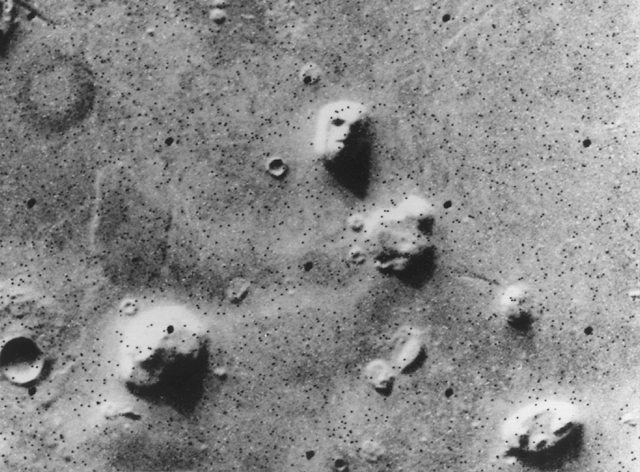
sidon esta en el paralelo 33
CYDONIA EN MARTE Y EL 33
| Reply |
Message 5 of 12 on the subject |
|
| From: Cajeli |
Sent: 04/09/2017 00:32 |
|
Este pasaje puede relacionarse con María Magdalena...
MATEO
15:21 Saliendo Jesús de allí, se FUE A LA REGIÓN DE TIRO Y SIDÓN.
15:22 Y he aquí una mujer cananea que había salido de aquella región clamaba, diciéndole: ¡Señor, Hijo de David, ten misericordia de mí! Mi hija es gravemente atormentada por un demonio.
15:23 Pero Jesús no le respondió palabra. Entonces acercándose sus discípulos, le rogaron, diciendo: Despídela, pues da voces tras nosotros.
15:24 El respondiendo, dijo: No soy enviado sino a las ovejas perdidas de la casa de Israel.
15:25 Entonces ella vino y se postró ante él, diciendo: ¡Señor, socórreme!
15:26 Respondiendo él, dijo: No está bien tomar el pan de los hijos, y echarlo a los perrillos.
15:27 Y ella dijo: Sí, Señor; pero aun los perrillos comen de las migajas que caen de la mesa de sus amos.
15:28 Entonces respondiendo Jesús, dijo: Oh mujer, grande es tu fe; hágase contigo como quieres. Y su hija fue sanada desde aquella hora.
15:29 Pasó Jesús de allí y vino junto al mar de Galilea; y subiendo al monte, se sentó allí.
15:30 Y se le acercó mucha gente que traía consigo a cojos, ciegos, mudos, mancos, y otros muchos enfermos; y los pusieron a los pies de Jesús, y los sanó;
15:31 de manera que la multitud se maravillaba, viendo a los mudos hablar, a los mancos sanados, a los cojos andar, y a los ciegos ver; y glorificaban al Dios de Israel.
15:32 Y Jesús, llamando a sus discípulos, dijo: Tengo compasión de la gente, porque ya hace tres días que están conmigo, y no tienen qué comer; y enviarlos en ayunas no quiero, no sea que desmayen en el camino.
15:33 Entonces sus discípulos le dijeron: ¿De dónde tenemos nosotros tantos panes en el desierto, para saciar a una multitud tan grande?
15:34 Jesús les dijo: ¿Cuántos panes tenéis? Y ellos dijeron: Siete, y unos pocos pececillos.
15:35 Y mandó a la multitud que se recostase en tierra.
15:36 Y tomando los siete panes y los peces, dio gracias, los partió y dio a sus discípulos, y los discípulos a la multitud.
15:37 Y comieron todos, y se saciaron; y recogieron lo que sobró de los pedazos, siete canastas llenas.
15:38 Y eran los que habían comido, cuatro mil hombres, sin contar las mujeres y los niños.
15:39 Entonces, despedida la gente, entró en la barca, y vino a la región de Magdala.
SIRIO ES LA CONSTELACION DEL PERRO/ CAN MAYOR
NOTEN EL NEXO DE DAN, CON LA SERPIENTE (VENECIA) Y EL CABALLO (PLAZA SAN MARCOS)
7. Génesis 49:17 Será Dan SERPIENTE junto al camino, Víbora junto a la senda, Que muerde los talones del caballo, Y hace caer hacia atrás al jinete.
VENECIA=PLAZA SAN MARCOS
11. Proverbios 25:11 MANZANA de oro con figuras de plata Es la palabra dicha como conviene.
12. Cantares 2:5 Sustentadme con pasas, confortadme con MANZANAs; Porque estoy enferma de amor.
13. Cantares 7:8 Yo dije: Subiré a la palmera, Asiré sus ramas. Deja que tus pechos sean como racimos de vid, Y el olor de tu boca como de MANZANAs,
ALLI ESTA LA CONEXION VENUS / VENECIA CON EL 666
VENUS= PENTAGONO= VENECIA= NUMERO DE ORO= 1.618033
LAS MATEMATICAS SON EXACTAS.
GLORIA A DIOS TODOPODEROSO. QUE BELLAS SON LAS MATEMATICAS
|
|
|
|
|
|
|
Ritual de Tránsito 2012
Venus, Enterprise y la Puerta del Dragón
Por Goro
(goroadachi.com y supertorchritual.com)
25 de mayo de 2012

Del 4 al 6 de junio de 2012 , probablemente veremos al miembro más antiguo de la flota de transbordadores espaciales, el Enterprise , siendo remolcado río Hudson hasta su lugar de descanso final, el Museo Intrepid del Mar, el Aire y el Espacio, en el West Side de Manhattan . [Actualización: Fechas cambiadas al 3-6 de junio ]. La mayoría lo desconoce por completo, pero será un reflejo terrestre del Tránsito de Venus que tendrá lugar simultáneamente en el cielo los días 5 y 6 de junio. Todo cuidadosamente organizado para crear un ejemplo exquisito de "como es arriba, es abajo"...


Cuando esto ocurra, el Enterprise entrará en el río Hudson por su desembocadura en el extremo sur de Manhattan, donde podremos visualizar una "puerta" flanqueada por la Estatua de la Libertad y el World Trade Center , donde antiguamente se alzaban las Torres Gemelas . La disposición refleja nítidamente la puerta celestial alrededor del Anticentro Galáctico , flanqueada por las constelaciones de Orión y Géminis . La Vía Láctea es un río (celestial) como el Hudson ; Orión es un " portador de antorcha " (el Sol del solsticio de verano = antorcha de Orión) como la Estatua de la Libertad ; y Géminis son los " Gemelos ", como las Torres Gemelas .
El Sol arriba, la Enterprise abajo. A través de una puerta galáctica arriba, a través de una puerta Hudson abajo. Es un espejo que une el cielo y la tierra.

Para retroceder un poco en el tiempo, el "ritual" comenzó el 27 de abril cuando Enterprise voló hacia la Gran Manzana montado sobre un Boeing 747 precisamente cuando Venus alcanzó su " mayor brillo " como Estrella Vespertina. La coincidencia implicaba una conciencia subyacente del próximo Tránsito de Venus, que será el momento de menor brillo cuando Venus se convierta en un punto negro en la cara del Sol (5 y 6 de junio) sin luz solar reflejada hacia la Tierra.

Como muestra el gráfico, Venus se está atenuando cada vez más, lo que continuará hasta principios de junio. Tras el tránsito, Venus renacerá como el
ACTUALIZACIÓN 27 de mayo: El pico en el otro lado, a mediados de julio, coincidirá aproximadamente con el debut del Enterprise en el museo Intrepid como exhibición oficial, completando su correlación con la línea de tiempo de Venus:
----- fin de actualización -----
Como saben los lectores habituales, cuando hablamos de Venus, y en particular de la Estrella de la Mañana, también nos referimos automáticamente al Príncipe Guillermo y/o a la trinidad William-Kate-bebé. Ambos van de la mano, profundamente entrelazados, como ya se ha explicado en numerosas ocasiones. Por lo tanto, no sorprende que la cronología más reciente de Venus coincida perfectamente con la de la Familia Real Británica: el 29 de abril (máximo brillo de Venus) marcó el primer aniversario de la Boda Real; del 3 al 7 de junio (tránsito de Venus/Enterprise) se celebra el cumpleaños oficial de la Reina (4 de junio) y el Jubileo de Diamante ( 4-7, 3-5 de junio); el solsticio de verano (antorcha de Orión) coincide con el cumpleaños del Príncipe Guillermo; y a finales de julio (bajo una Estrella de la Mañana/portadora de luz muy brillante), la Antorcha Olímpica llega a Londres para los Juegos Olímpicos de 2012.
En términos de la órbita de la Tierra alrededor del Sol, el 27 de abril (la llegada del Enterprise a la Gran Manzana ) fue una ventana con el ápice de un pentagrama (núcleo de la manzana)...

  

El pentagrama es una firma geométrica de Venus, lo que tiene mucho sentido en el contexto actual.
Y la manzana tiene el efecto adicional de recordar a la Familia Real Británica a través del Rey Arturo , cuyo Santo Grial ( San Greal ) o "Sangre Real" ( Sang Real ) es de vital importancia para la realeza en Gran Bretaña. El linaje jacobita del Príncipe Guillermo y su futuro hijo tiene mucho que ver con el tema subyacente de este período, es decir, el "Regreso/Renacimiento del Rey Arturo", intercambiable con la "Resurrección de Lucifer/Fénix" , etc. (Consulte mi artículo " El Destino de Lucifer " para más información sobre el tema). Si el Rey Arturo ha de "regresar", sería desde Ávalon , donde se cree que el antiguo y futuro Rey hiberna. Resulta que el nombre "Ávalon" significa " manzana ".
|
|
|
 Primeira Primeira
 Anterior
15 a 29 de 29
Seguinte Anterior
15 a 29 de 29
Seguinte
 Última
Última

|

